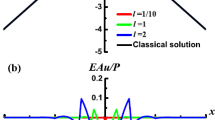Abstract
The peridynamic model of solid mechanics is a nonlocal theory containing a length scale. It is based on direct interactions between points in a continuum separated from each other by a finite distance. The maximum interaction distance provides a length scale for the material model. This paper addresses the question of whether the peridynamic model for an elastic material reproduces the classical local model as this length scale goes to zero. We show that if the motion, constitutive model, and any nonhomogeneities are sufficiently smooth, then the peridynamic stress tensor converges in this limit to a Piola-Kirchhoff stress tensor that is a function only of the local deformation gradient tensor, as in the classical theory. This limiting Piola-Kirchhoff stress tensor field is differentiable, and its divergence represents the force density due to internal forces. The limiting, or collapsed, stress-strain model satisfies the conditions in the classical theory for angular momentum balance, isotropy, objectivity, and hyperelasticity, provided the original peridynamic constitutive model satisfies the appropriate conditions.
Similar content being viewed by others
References
Silling, S.A.: Reformulation of elasticity theory for discontinuities and long-range forces. J. Mech. Phys. Solids 48, 175–209 (2000)
Silling, S.A., Epton, M., Weckner, O., Xu, J., Askari, E.: Peridynamic states and constitutive modeling. J. Elast. 88, 151–184 (2007)
Lehoucq, R.B., Silling, S.A.: Statistical coarse-graining of molecular dynamics into peridynamics. Report SAND2007-6410, Sandia National Laboratories, Albuquerque, New Mexico (2007)
Silling, S.A., Askari, E.: A meshfree method based on the peridynamic model of solid mechanics. Comput. Struct. 83, 1526–1535 (2005)
Emmrich, E., Weckner, O.: Analysis and numerical approximation of an integro-differential equation modeling non-local effects in linear elasticity. Math. Mech. Solids 12, 363–384 (2007)
Silling, S.A., Bobaru, F.: Peridynamic modeling of membranes and fibers. Int. J. Nonlinear Mech. 40, 395–409 (2005)
Bobaru, F.: Influence of van der Waals forces on increasing the strength and toughness in dynamic fracture of nanofibre networks: a peridynamic approach. Model. Simul. Mat. Sci. Eng. 15, 397–417 (2007)
Bazant, Z.P., Jirasek, M.: Nonlocal integral formulations of plasticity and damage: Survey of progress. J. Eng. Mech. 128, 1119–1149 (2002)
Gerstle, W., Sau, N., Silling, S.: Peridynamic modeling of concrete structures. Nucl. Eng. Des. 237, 1250–1258 (2007)
Truesdell, C.: A First Course in Rational Continuum Mechanics. Volume I: General Concepts. Academic, New York (1977), pp. 120–121
Giessibl, F.J.: Atomic resolution of the silicon (111)-(7×7) surface by atomic force microsopy. Science 267, 68–71 (1995)
Kuo, S.C., Sheetz, M.P.: Force of single kinesin molecules measured with optical tweezers. Science 260, 232–234 (1993)
Block, S.M.: Making light work with optical tweezers. Nature 360, 493–495 (1992)
Maranganti, R., Sharma, P.: Length scales at which classical elasticity breaks down for various materials. Phys. Rev. Lett. 98, 195504-1–195504-4 (2007)
Israelachvili, J.: Intermolecular and Surface Forces. Academic, New York (1992), pp. 155–157, 177
Abraham, F.F., Brodbeck, D., Rafey, R.A., Rudge, W.E.: Instability dynamics of fracture: A computer simulation investigation. Phys. Rev. Lett. 73, 272–275 (1994)
Eringen, A.C., Speziale, C.G., Kim, B.S.: Crack-tip problem in non-local elasticity. J. Mech. Phys. Solids 25, 339–355 (1977)
Irving, J.H., Kirkwood, J.G.: The statistical mechanical theory of transport processes. IV. The equations of hydrodynamics. J. Chem. Phys. 18, 817–829 (1950)
Noll, W.: Die Herleitung der Grundgleichungen der Thermomechanik der Kontinua aus der statistischen Mechanik. J. Ration. Mech. Anal. 4, 627–646 (1955)
Hardy, R.J.: Formulas for determining local properties in molecular-dynamics simulations: Shock waves. J. Chem. Phys. 76, 622–628 (1982)
Murdoch, A.I.: On the microscopic interpretation of stress and couple stress. J. Elast. 71, 105–131 (2003)
Zimmermann, M.: A continuum theory with long-range forces for solids. Ph.D. thesis, Massachusetts Institute of Technology, Department of Mechanical Engineering (2005)
Emmrich, E., Weckner, O.: On the well posedness of the linear peridynamic model and its convergence towards the Navier equation of linear elasticity. Commun. Math. Sci. 5, 851–864 (2007)
Lehoucq, R.B., Silling, S.A.: Force flux and the peridynamic stress tensor. J. Mech. Phys. Solids 56, 1566–1577 (2008)
Mindlin, R.D.: Micro-structure in linear elasticity. Arch. Ration. Mech. Anal. 16, 51–78 (1964)
Aifantis, E.C.: Strain gradient interpretation of size effects. Int. J. Fract. 95, 299–314 (1999)
Fleck, N.A., Hutchinson, J.W.: A reformulation of strain gradient plasticity. J. Mech. Phys. Solids 49, 2245–2271 (2001)
Gurtin, M.E.: An Introduction to Continuum Mechanics. Academic, New York (1981), pp. 165–180
Abeyaratne, R.: An admissibility condition for equilibrium shocks in finite elasticity. J. Elast. 13, 175–184 (1983)
Dayal, K., Bhattacharya, K.: Kinetics of phase transformations in the peridynamic formulation of continuum mechanics. J. Mech. Phys. Solids 54, 1811–1842 (2006)
Howison, S.D., Ockendon, J.R.: Singularity development in moving-boundary problems. Q. J. Mech. Appl. Math. 38, 343–359 (1985)
Sahu, S.K., Das, P.K., Bhattacharyya, S.: Rewetting analysis of hot surfaces with internal heat source by the heat balance integral method. Heat Mass Transf. (2007). doi:10.1007/s00231-007-0360-6
Author information
Authors and Affiliations
Corresponding author
Rights and permissions
About this article
Cite this article
Silling, S.A., Lehoucq, R.B. Convergence of Peridynamics to Classical Elasticity Theory. J Elasticity 93, 13–37 (2008). https://doi.org/10.1007/s10659-008-9163-3
Received:
Accepted:
Published:
Issue Date:
DOI: https://doi.org/10.1007/s10659-008-9163-3




